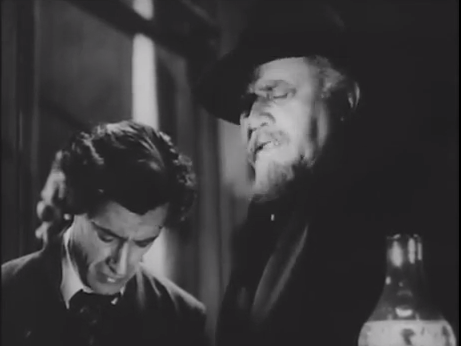Bluebeard

Main Credits
Director: Edgar G. Ulmer. Screenplay: Pierre Gendron. Producer: Leon Fromkess. Directors of Photography: Jockey A. Feindel, Eugen Schufftan (uncredited). Music: Erdody. Art Director: Paul Palmentola. Cast: John Carradine (Gaston Morrell), Jean Parker (Lucille), Nils Asther (Insp. Lefevre), Ludwig Stossel (Jean Lamarte), George Pembroke (Insp. Renard), Teala Loring (Francine), Sonia Sorel (Renee), Henry Kolker (Deschamps), Emmett Lynn (Le Soldat), Iris Adrian (Mimi), Patti McCarty (Babette), Carrie Devan (Constance), Anne Sterling (Jeanette). Released: PRC, November 11, 1944. 72 minutes.
From Film Noir: The Encyclopedia
Plot Summary
Lucille and two friends bump into Morrell. He invites them to a puppet opera of Faust. After the show he meets alone with Lucille. Another puppeteer, Renee, gets jealous. She asks Morrell why he gives her job temporarily to other women and then takes her back. When she asks what happened to the women, he strangles her. Before Morrell murders women, he paints their portraits, which are sold abroad. However, one portrait stays in Paris. It is publicly exhibited and the police recognize the woman as Bluebeard’s fourth victim. They question the city’s models, but none of them can identify the painter. Lemarte, the painter’s art dealer, is offered a lot of money to get the painter to do a portrait of Francine, an undercover agent. However, the police spring their trap too late and Morrell escapes, leaving behind Francine and Lemarte dead. Unintentionally, Lucille reveals to Inspector Lefevre that she’s suspicious Morrell is Bluebeard. When she goes to Morrell’s home, the police secretly follow. The police break in and chase Morrell to the rooftop. Losing his footing, Morrell falls to his death in the Seine, the river from which the police had fished out his victims.
Commentary
Although Bluebeard is set in 19th. century Paris, it relates to wartime America by depicting a large population of single women, holding jobs and enjoying nightlife. Two of these women, the sisters Lucille and Francine, are responsible for ending Morrell’s murder spree. When the men in the police department can’t figure out the identity of Bluebeard, they call in Francine to lead the investigation. She comes up with the plan that lures the killer into the open. Lucille, a seamstress, recognizes the cravat she mended for Morrell was a murder weapon.
Because Morrell is attracted to Lucille as a lovely yet modest woman, he opens up to her about what made him start killing. He says he saw a woman, Jeanette, collapse in the street. He took care of her in his house. He painted her as the “Maid d’Orleans” (Joan of Arc, a virgin). After she got well, she disappeared. He searched for her and when he found her, he saw she was a woman with sexuality and money.
Outraged at the “real” Jeanette, he strangled her. Morrell’s confession reveals that, while Jeanette was bedridden and dependent on him, he developed an idealization of her. When he discovers his image of female purity doesn’t match reality, he kills Jeanette for “defiling” that image. Afterwards, in a city filled with independent women, Morrell murders one more “Jeanette” after another.
Morrell’s other reason for killing women, which he doesn’t tell Lucille, is to make ends meet. Lamarte, Morrell’s landlord and art dealer, procures the victims. After Morrell paints a woman, he strangles her and gives the painting to Lamarte, who sells it and pockets most of the money. With the leftover he gets from Lamarte, Morrell pays his rent and has the leisure to create puppets.

After the Faust opera, Morrell tells Lucille that each puppet resembles someone he knows. He refers to Mephistopheles as “the evil one” and his “business manager.” The face of Mephistopheles, with its outwardly pointing beard, is a dead-ringer for Lamarte. However, it is Lamarte who pulls Morrell’s strings. Morrell is unable to refuse any of Lamarte’s demands for another painting, though both of them know it means another murder. Manipulated by Lamarte to keep painting for blood money and powerless to stop strangling the women he paints, Morrell is only in control of the little wooden people he carves.
